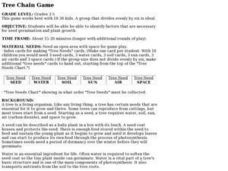Scholastic
Study Jams! Mosses and Ferns
Mosses and ferns are some of the world's oldest types of plants. Here is a quality 10-slide presentation set to gentle background music for beginning botanists to view and enjoy. Accompanying captions explain that these are both...
National Christmas Tree Association
Merry Christmas, Geraldine
If you're reading the story "Merry Christmas, Geraldine" by Holly Keller, this is a fantastic cross-curricular resource to use. Complete with activities for language arts, science, social studies, art, and math, you'll get the most out...
Curated OER
Biomes and Plant Growth
Seventh graders design four biomes models and plant three types of seeds in them to observe growth. In groups for each type of biome, they predict the seeds' growth in each of the settings. Students follow the conditions on a biome chart...
Curated OER
Plant Life Cycles
Follow the life cycle of a dandelion with a lab sheet for kindergartners. They learn about the order of events in a dandelion's life, then put the stages of life in order. Can they describe the life cycle of a pumpkin? For extra...
Curated OER
Dirt Babies
Dirt babies are an excellent way to show young botanists the plant life cycle. They explore the functions and industry behind grasses before growing some of their own. Use the informational text here and consider implementing some...
Curated OER
Which Plants Grew Best?
This presentation gives a visual account of a class's experiment growing sprouts under different conditions. There are three containers with the same soil and the same seeds. One of the containers got water, but no light. One got light,...
Virginia Department of Education
A-Mazing Plants
Have your young scientists questioned why plants grow a particular way? Through this learning opportunity, scientists gain firsthand knowledge about how plants develop and various factors that affect rates of growth as they bring plants...
Curated OER
Tree Chain Game
Students identify the necessary factors for seed germination and plant growth in a game format.
Curated OER
Grow Your Own
Students study the growth and care of plants. They take tour of their school site and plant seeds to observe their growth. Afterward, they answer questions about the origin and value of their plants.
Curated OER
Lets Think About...Plants
Students bring in various vegetables and make friendship soup. They plant seeds and discuss the things plants need to grow and thrive.
Curated OER
Weedy Socks & Wheels
Students engage in a lesson plan that is concerned with the concept of using socks in order to collect weed seeds. They conduct research in order to illustrate the ease of how weeds are spread from one area to another. Students conduct...
Curated OER
Herb is the Word
Learners conduct an experiment to determine how different soils affect plant growth over a six-week period. After determining the physical properties of different types of soil, students plant various types of seeds into the soil...
Curated OER
A Botanists View
Students explore plant and seed structure. They dissect a seed and identify its parts. In addition, they explain the function and compare and contrast monocotyledon and dicotlyledons.
Curated OER
Plants
Pupils plant bean seeds and draw pictures of the plants as they grow. They create their own garden, plant the seeds, and keep a journal of their growth.
Curated OER
Springtime Party Favors
Students plant a flower in a keepsake pot. In this art lesson students each plant a seed in a small pot. The students take their pot with the planted seed home.
Curated OER
Don't Wait, Just Propagate
Students explore the process of growing plants from seed. In this propagation activity, students examine methods of propagation and determine how to rapidly propagate plant species. Students listen to a lecture informing them on the...
Curated OER
How do rice farmers make good use of the land they use for planting rice?
Second graders discuss how farmers grow rice. In this rice growing lesson, 2nd graders see the optimal condition for land in order to grow rice. They experiment with clay and garden soil to see which holds water better.
Curated OER
What Are Heritage Plants?
Students listen to a story, plant seeds, and study about heritage seeds. They read seed packages for plant needs and sizes, plant seeds. They read story "How Groundhog's Garden Grew" which covers many activities of planting, growing...
Curated OER
Kitchen Garbage: Starting Sweet Potato Vines
In this sweet potato worksheet, students follow directions on how to grow a sweet potato and answer short answer questions. Students answer 2 short answer questions.
Curated OER
Dry-Land Kalo-Growing New Plants from Stems
Students explore Hawaiian plants. For this Hawaii culture and botany lesson, students plant the haha(stem) of a taro plant. Students listen to Hawaiian myths about the taro plant and chorally speak a Hawaiian chant of protection....
Curated OER
Growing Corn
Sixth graders create a Venn diagram of different soil types. They plant cord seeds in clay, sand, and fertile black soils are record their growing rates. After two weeks they discuss the effects of soil types on the growth process.
Curated OER
Growing Jack and the Beanstalk Plants
First graders investigate how plants grow by growing their own "beanstalk", (after reading "Jack and the Beanstalk") and record their observations daily in a science journal.
Curated OER
Salinity Of Soil
Fourth graders investigate the contents of various types of soil to determine the differences in salinity levels. They conduct an experiment of observing the plants in the different soils. Students then determine survival rates by...
Curated OER
Grow Your Own Grub
Students study plant needs and growth by completing a gardening activity. In this plant study lesson, students watch a video and discuss plant growth needs. Students plant seeds in containers and water the plants. Students take photos of...

























